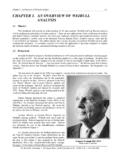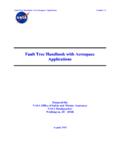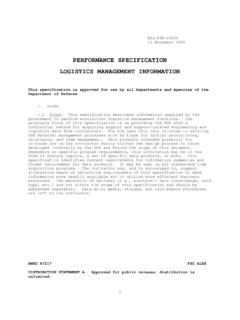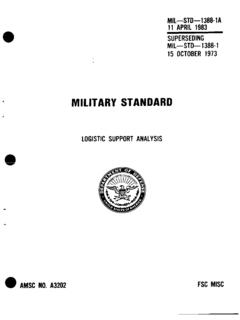Transcription of Predict Failures: Crow-AMSAA 101 and Weibull 101
1 Copyright 2004 by the Kuwait Society of Engineers. All rights reserved. Page 0 of 14 Predict Failures: Crow-AMSAA 101 and Weibull 101 Paul Barringer, Barringer & Associates, Inc. Box 3985 Humble, TX 77347-3985 USA Phone: 1-281-852-6810 FAX: 1-281-852-3749 Email: Web: International Mechanical Engineering Conference Kuwait December 5-8, 2004 Copyright 2004 by the Kuwait Society of Engineers. All rights reserved. Page 1 of 14 Proceedings of IMEC 2004 International Mechanical Engineering Conference December 5-8, 2004, Kuwait IMEC2004-FM201-CP Predict Failures: Crow-AMSAA 101 and Weibull 101 Paul Barringer, Barringer & Associates, Inc.
2 Box 3985 Humble, TX 77347-3985 USA Email: Abstract Reliability growth plots known as Crow-AMSAA plots are powerful for predicting future failures for mixed failure modes. Weibull probability plots are powerful single failure mode tools for predicting the type of failure mode which guides reliability centered maintenance strategies and forecasting future failures for each failure mode. Both analytical tools are minimum requirements for every reliability engineer s the tool box.
3 Real data examples are shown to illustrate the value for acquiring engineering/maintenance data and using these basic tools to give the data a voice. Giving data an unemotional voice is a rational for decisions and for corrective action. Examples and illustrations describe the basics of each tool. Keywords: Crow-AMSAA plots, reliability growth plots, Weibull probability plots, Weibull analysis, failure forecast, failure modes, data, maintenance data, reliability analysis.
4 Data Most chemical plants, refineries, and manufacturing systems have objective, variables type data in computerized maintenance management (CMMS) systems. The data is used in two ways: 1) cumulative time vs cumulative failures for Crow-AMSAA (C-A) plots and 2) age-to-failure for Weibull plots. Data acquisition is simpler for C-A plots than for Weibull plots. Weibull plots provide smarter information than C-A plots, such as failure modes; and the Weibull methodology allows forecast of future failures knowing only the age of survivors and statistics about the way the population fails.
5 For C-A plots, the X-axis is often simply chronological time which is a cumulative number. When the fleet size is changing (up or down) accumulate time in cumulative fleet time, ( , cumulative fleet hours) so as to get the cumulative time events in the correct relationship. C-A plots require cumulative time versus cumulative failures (or cumulative events). They make reliability visible. Weibull data must be presented in the format of age to failure. You must know the birth date of the component (time zero) and you must know the death date of the component with the elapsed Copyright 2004 by the Kuwait Society of Engineers.
6 All rights reserved. Page 2 of 14 time resulting in an important statistic called age-to-failure. In short, you must produce data as occurs with humans, as their death certificates usually state the chronological age and reason(s) for death. For humans, we report life in years although for equipment the age-to-failure can be years, cycles, burn-out cycles, hours in service plus a multiplier times the number of burn-out cycles, hours of use plus hours of idleness, etc.
7 For motivation toward failures. CMMS systems must reduce the mass of data into simple statistics for rational subsets of data with ages-to-failure, for example the loads, sizes and types of bearings have considerable variability and cannot be lumped together for details analysis; although at a very high altitude lumping data together with simple arithmetic mean times to failure (MTTF) for non repairable items and mean times between failure (MTBF) for repairable items may be as helpful as a moisten finger held vertically to find the direction of the wind.
8 Some items do not die (fail) in service and contain censored information about their death date. Some items are removed without failure after acquiring some age and we can never know how much remaining life existed in the item as equipment fails on a probabilistic basis rather than a deterministic basis. Censored data (or the synonym for censored data is suspended data) is useful for reliability calculations, therefore do not discard the suspended data as it contains valuable information.
9 Also failures from an event rather than an aging event results in censored data. This means you must record the censored data in your CMMS along with reasons for removal. More will be said below about suspended data for Weibull analysis. Censored data can also exist for C-A plots and the censored information will be contained only in the last data point in a C-A plot which contains time but it has not yet reached the next failure. To acquire failure data, you must define what constitutes a failure.
10 Without a rational definition of failure, each person will record something different, and this will result in data chaos and inconsistencies. Without a well understood definition of failure, arguments ensue which generates much heat but little light will be shed on the issues. Modern medicine has shown the value of attaching specific names to illnesses rather than just reporting the patient is sick. Consider your opinion of your doctor if your personal medical record simply reported you visited the doctor on a certain date and the cause was reported only as sick ----you would view your personal medical history as wholly ineffective for building your medical case history.











